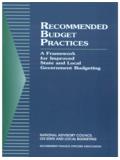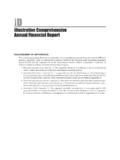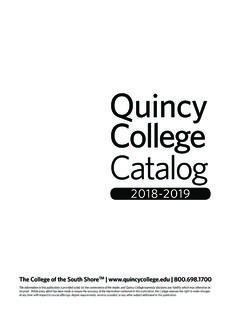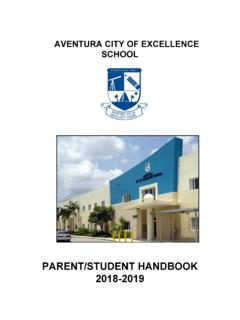Transcription of Government finance officers association Certificate …
1 Government finance officers association Certificate of achievement for excellence in Financial reporting GENERAL PURPOSE GOVERNMENTS. SRC REVIEW GUIDE. (Available electronically at )1. GFOA has prepared a comprehensive checklist for preparers of financial reports of general purpose governments. GFOA. professional staff make use of that checklist to perform a detailed review of every report submitted to the Certificate of achievement for excellence in Financial Reporting Program ( Certificate Program). A substantial number of the questions on the checklist address purely factual matters or formatting issues that can be resolved easily and objectively during the staff review. Members of GFOA's Special Review Committee (SRC) are welcome, of course, to use that same comprehensive checklist to perform their own reviews for the Certificate Alternatively, SRC members who prefer to focus their limited time on the more substantive aspects of the reports they are to review may use GFOA's attached SRC Review Guide, with the full assurance that other more routine aspects of the review will be fully covered as part of the GFOA staff review.
2 When using these guidelines please note: Indentation indicates that a question is only relevant if the response to the preceding question is positive. Explanations or comments follow the relevant question. A plus sign ( + ) indicates that the answer to a question in section VI of the application form determines whether the particular question is relevant to the Government . An asterisk ( * ) indicates that a no response to the question is potentially sufficient to deny the Certificate . Reviewers are especially encouraged to provide narrative comments on any deficiencies they may encounter in the course of their review. Reviewers should e-mail their VOTE PAGE3 and any narrative comments to A reference to a page number(s) in the CAFR should accompany each deficiency noted by the reviewer (there is no need to reference the question number). 2015 No reprinting, reproduction, or distribution of this material is permitted without the prior written consent of the GFOA.
3 1. An electronic version of this Guide can be found by selecting the Award Programs heading at the GFOA home page and then selecting Certificate of achievement for excellence in Financial Reporting. Scroll down, as necessary, to find the item. 2. An electronic version of the comprehensive checklist for preparers can be found by selecting the Award Programs heading at the GFOA home page and then selecting Certificate of achievement for excellence in Financial Reporting. Scroll down, as necessary, to find the item. 3. An electronic version of the Vote Page can be found by selecting the Award Programs heading at the GFOA home page and then selecting Certificate of achievement for excellence in Financial Reporting. Scroll down, as necessary, to find the item. Abbreviations Used in this Checklist SLG - Audits of State and Local Governments, American Institute of Certified Public Accountants, March 1, 2013. eGAAFR Governmental Accounting, Auditing, and Financial Reporting (e-book format), GFOA 2012/2014.
4 ESUP GAAFR Supplement (available only in e-book format), GFOA 2014. GAAFR - Governmental Accounting, Auditing, and Financial Reporting, GFOA 2012. GAAP - Generally accepted accounting principles GASB - I - GASB Interpretation GASB - S - GASB Statement GASB - TB - GASB Technical Bulletin Q&A - 2013-2014 Comprehensive Implementation Guide, GASB. NCGA - I - National Council on Governmental Accounting Interpretation NCGA - S - National Council on Governmental Accounting Statement All references listed above, except those for GAAFR, eGAAFR, eSUP, Q & A, and SLG, are followed by the number of the pronouncement, if applicable, and the specific paragraph(s), footnote(s), or appendix (appendices) within the publication that is being referenced. The references to GAAFR are to pages in that publication. For eGAAFR and eSUP . the references are to the page number in Adobe Digital Editions for the electronic file. For Q&A, the references are to the applicable chapters and questions in that publication.
5 For SLG, the references are to the chapter and specific paragraph. 2. [SECTION 1, COVER, TABLE OF CONTENTS, AND FORMATTING, HAS BEEN OMITTED FROM THESE GUIDELINES]. INTRODUCTORY SECTION. LETTER OF TRANSMITTAL. Does the letter of transmittal include background information on the Government ? [GAAFR, page 593]. Does the letter of transmittal contain information designed to assist users in assessing the Government 's economic condition ( , information on the local economy)? [GAAFR, page 593]. Explanation: Examples of other types of information that might be useful in assessing a Government 's economic condition include information associated with a Government 's long-term financial planning, financial policies that were relevant in the current period ( , the application in the current period of the Government 's policy on the use of one-time revenue sources), and major initiatives that are expected to affect future financial positions. Has the Government refrained from duplicating information contained in MD&A or in the notes to the financial statements in the letter of transmittal?
6 [GASB-S34:8, note 7; Q GAAFR, pages 591-2]. Explanation: The GAAFR suggests three means of avoiding unnecessary duplication: 1) briefly identifying a topic and explaining its potential interest to financial statement users in the letter of transmittal, 2) referring readers of the letter of transmittal to the notes and MD&A for any information on the topic already provided there, and 3) limiting the discussion in the letter of transmittal to the more subjective aspects of a given topic. [SECTION 3, FINANCIAL SECTION REPORT OF THE INDEPENDENT AUDITOR, HAS BEEN OMITTED FROM THESE GUIDELINES]. FINANCIAL SECTION MANAGEMENT'SDISCUSSION AND ANALYSIS (MD&A). Does MD&A provide an overall analysis of the Government 's financial position and results of operations? [GASB- S34:11c; GAAFR, page 569]. Explanation: Analysis, properly speaking, should focus on the reasons for changes rather than just their sizes. Review the condensed financial information to identify areas with significant changes that should be included in the analysis.
7 Does MD&A specifically address whether the Government 's overall financial position has improved or deteriorated? [GASB-S34:11c; GAAFR, page 569]. Explanation: It is not necessary for the discussion to use the word improved or deteriorated. A statement that net position has increased or decreased is sufficient. Does MD&A provide an analysis of significant balances and transactions of individual major funds? [GASB- S34:11d; GAAFR, page 569]. Explanation: Analysis, properly speaking, should focus on the reasons for changes rather than just their sizes. Normally, the analysis of individual funds is provided separately from the overall analysis described in question However, sometimes governments combine the overall analysis and the fund analysis. Either approach is acceptable as long as the analysis includes reasons for both the changes for each type of activity and for the individual major funds, as necessary ( , those with significant balances and/or transactions).
8 Does MD&A address whether restrictions, commitments, or other limitations significantly affect the availability of fund resources for future use? [GASB-S34:11d; GAAFR, page 569]. Does MD&A provide an analysis of significant budgetary variations (both original budget versus final amended budget and final amended budget versus actual) for the general fund? [GASB-S34:11e; GAAFR, page 570]. 3. Does MD&A describe significant capital asset and long-term debt activity during the year? [GASB-S34:11f;. GAAFR, pages 570]. Explanation: This discussion should summarize, rather than repeat, the detailed information presented in the notes. It also should address commitments made for capital expenditures, changes in credit ratings, and debt limitations that may affect the financing of planned facilities or services. Has the Government refrained from addressing in MD&A topics not specifically prescribed by SGAS 34? [GASB- S37:4-5; Q GAAFR, page 568]. Explanation: Governments may address in MD&A only those topics specifically identified in SGAS 34, paragraph 11.
9 Governments are free, however, to provide whatever level of detail they believe appropriate in addressing these particular topics. FINANCIAL SECTION BASIC FINANCIAL STATEMENTS. (PRELIMINARY CONSIDERATIONS). PLEASE NOTE: Questions and identify the items that are appropriately reported as deferred outflows of resources and deferred inflows of resources before the implementation of GASB Statement No. 68, Accounting and Financial Reporting for Pensions and GASB Statement No. 71, Pension Transition for Contributions Made Subsequent to the Measurement Date. For those governments that have implemented GASB Statement No. 68 and GASB Statement No. 71 for pension plans that are administered through a trust or equivalent arrangement please refer to the Checklist Supplement following section 19 of this checklist for additional items that those statements identify as deferred outflows of resources and deferred inflows of resources for such pension plans. * If the Government -wide and fund statements of position ( , the statement of net position or the balance sheet, where applicable) present deferred outflows of resources are the items presented as such limited to those items specifically identified by GAAP for reporting in the category?
10 [GASB-S63:7]. Explanation: GASB Concepts Statement No. 4 established deferred outflows of resources as a financial statement element. However, that guidance states that only amounts identified by the GASB in authoritative pronouncements can be reported in the category. Following is the pronouncement and the item it identifies that can be reported as a deferred outflow of resources: The fair value of effective hedges that are in a loss position ( , the cumulative amount of the fair value changes of the effective hedge is a debit). [GASB-S53:20]. For current refundings and advance refundings resulting in defeasance of debt the excess of the reacquisition price of the old debt over its net carrying amount [GASB-S65:5-6]. A change in the provisions of a current capital lease that results from a current or advance refunding by the lessor who passes through the effect to the lessee (and the lease continues to qualify as a capital lease) which increases the lessee's lease obligation [GASB-S65:7].

















